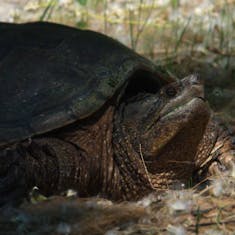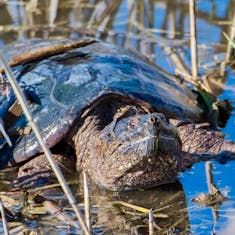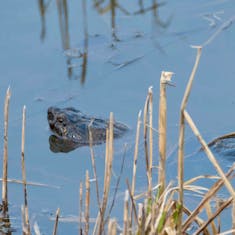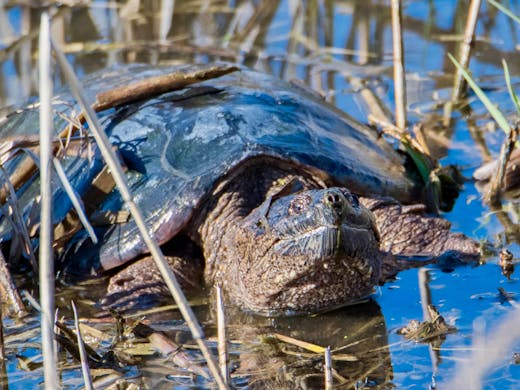Common Snapping Turtle Chelydra serpentina
Largest turtle in the Montreal area. Difficult to spot as it moves slowly, mostly submerged just below the surface of the water, and barely lifting its head out of the water from time to time to breath.
Specs
| Length | 30-50cm |
| Weight | 9-16kg |
Common Names
| German | Schnappschildkröte |
| English | Common Snapping Turtle |
| French | Tortue serpentine |
| Spanish | Tortuga mordedora |
Taxonomy
| Order | Testudines |
| Family | Chelydridae |
| Species | Chelydra serpentina |
Advertisement
We need your help! By making a contribution towards our hosting costs, you can help us provide an ad-free experience on our website in the near future. Paypal
How to Identify
Usually size is not a good characteristics to distinguish a species from other. Different in this case. Adults are up to half a meter in length, way larger than other turtles in the area. Also different to other turtles is the bulky, muscular build around head and legs.



Common Snapping Turtle Trivia
Can the Common Snapping Turtle retract its head and limbs?
No, unlike most turtles, the common snapping turtle cannot fully withdraw its head and limbs into its shell. This makes it more vulnerable to predators but also more aggressive when threatened.
Is the Common Snapping Turtle herbivorous?
No, this turtle species is omnivorous, meaning it eats both plants and animals. Its diet includes fish, frogs, snakes, birds, small mammals, insects, algae, and aquatic plants.
Does the Common Snapping Turtle have a lifespan of over 100 years?
No, it has a lifespan of about 30 to 40 years in the wild and up to 70 years in captivity. However, some individuals may live longer than that.
Does the Common Snapping Turtle lay eggs in water?
No, it lays eggs on land, usually in sandy or loamy soil near water. The female digs a hole with her hind legs and deposits 20 to 80 eggs, which hatch after 9 to 18 weeks, depending on the temperature.
Is the Common Snapping Turtle endangered?
No, but it is threatened by habitat loss, road mortality, illegal harvesting, and pollution. This turtle species is listed as a species of special concern in Canada and some states in the US. It is also protected by various laws and regulations.
Is the Common Snapping Turtle the largest freshwater turtle in Canada?
Yes, this turtle species can weigh up to 16 kg and measure up to 47 cm in carapace length. It is the largest freshwater turtle in Canada and one of the largest in North America.
Does the Common Snapping Turtle have teeth?
No, it does not have teeth, but it possesses a sharp beak capable of cutting through flesh and bone. Additionally, the common snapping turtle has powerful jaws that can exert a bite force of up to 210 N.
Does the Common Snapping Turtle hibernate in winter?
Yes, it hibernates during the winter, typically at the bottom of lakes, ponds, or rivers. It buries itself in mud or vegetation, slowing down its metabolism and heart rate. It can survive for months without oxygen by utilizing anaerobic respiration.
Does the Common Snapping Turtle have any predators?
Yes, this turtle species does have predators, especially when it is young or laying eggs. Its predators include raccoons, skunks, foxes, coyotes, crows, herons, and eagles.
Does the Common Snapping Turtle communicate with sounds?
Yes, this species communicates through sounds, particularly during the mating and nesting season. It can produce hisses, grunts, clicks, and clucks to attract mates or deter rivals. The hatchlings can also communicate with each other and their mother using peeps and squeaks.
Does the Common Snapping Turtle have any parasites?
Yes, this turtle species hosts numerous parasites, both internal and external. Some of these parasites include leeches, ticks, mites, worms, flukes, and protozoans. Certain parasites can cause diseases or reduce the fitness of the host.
Is the Common Snapping Turtle related to dinosaurs?
No, it is not related to dinosaurs, but it is one of the oldest living reptiles, with a history dating back approximately 40 million years. The common snapping turtle shares some features with ancient reptiles, such as crocodilians and turtles from the Cretaceous period.
Where and When to Spot
Best time to look for the Common Snapping Turtle is spring, after the ice has melted before the growth of the foliage which will provide perfect cover later in spring. Occasionally, you may see this species on land while crossing from one pond to another.
| Spring | Summer | Fall | Winter | |
|---|---|---|---|---|
| Parc Angrignon | x | - | - | - |
Where and when a species has been observed, identified, and recorded.
